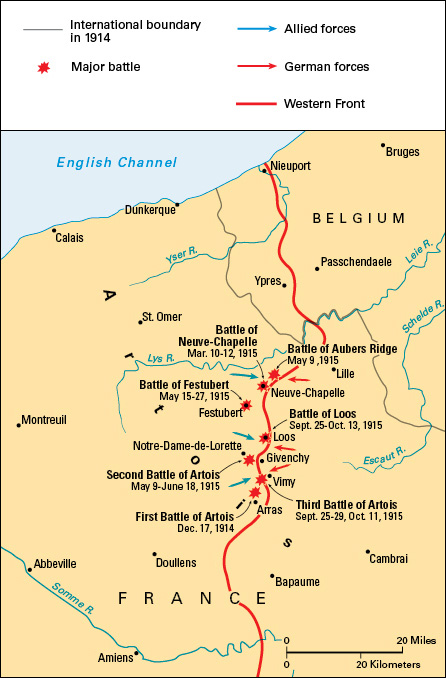Artois, Battles of, were a series of Allied assaults on German forces during World War I (1914-1918). The assaults took place in the northern French region of Artois from December 1914 to October 1915. The battles were among the first major engagements to occur after the opposing armies fought to a standstill on the Western Front, the battlefront through Belgium and France . Allied forces gained some ground in the battles, but the attacks failed to break the German lines. This article discusses the largest of the battles that took place in the Artois region during that time period.
Background.
In August 1914, Allied troops—mainly the French and British, along with Belgian and colonial forces—began battling German forces in Belgium and northern France. The Allies stopped the invading Germans north of Paris in September. In October, a series of maneuvers by both sides drove the battlefront north and west toward the English Channel . During this “race to the sea,” a number of small battles took place in Artois. Allied and German troops then dug in, creating strongly fixed defensive lines all along the Western Front.

The Battles of Artois were the first of numerous attempts to break the deadlock of trench warfare (fighting from fortified ditches) on the front. At times, the British and French coordinated attacks on the same dates to support one another.
First Battle of Artois.
On Dec. 17, 1914, French troops attacked German positions near the city of Arras. The assault failed badly, with many French casualties (people killed, wounded, missing, or captured). On December 19, Indian Corps and British troops attacked the German defenses near the villages of Givenchy and Festubert. These assaults also failed. The need to bury large numbers of dead on the battlefields contributed to the Christmas Truce , an informal cease-fire along isolated parts of the Western Front.

Battle of Neuve-Chapelle.
On March 10, 1915, British and Indian troops attacked near the village of Neuve-Chapelle. They took parts of the German front line, including Neuve-Chapelle. Bloody fighting continued through March 12, when German counterattacks stopped the advance. The British and Indian troops gained about 1/2 mile (1 kilometer) of ground, and they failed to take the slight rise of Aubers Ridge. Both sides suffered around 12,000 casualties.
Second Battle of Artois.
On May 9, French and North African troops launched a large offensive north of Arras. They attacked on the high ground of Notre-Dame-de-Lorette and toward Vimy Ridge. The German front line collapsed, and the French force quickly advanced more than 2 miles (5 kilometers). French reserves were unable to support the advance, however, and German counterattacks drove the French back. Savage combat continued in the area until June 18. For limited gains, French casualties in the battle topped 100,000. German casualties were high too—around 73,000.
Battles of Aubers Ridge and Festubert.
Also on May 9, British troops again tried to take Aubers Ridge. However, the disastrous attack was called off after one day. From May 15 to May 27, British, Canadian, and Indian troops fought German forces for possession of Festubert. The Allies eventually captured the village, advancing just over 1/2 mile (1 kilometer). The Allies suffered some 30,000 casualties at Aubers Ridge and Festubert.
Third Battle of Artois.
On September 25, the French renewed their attempt to take Vimy Ridge. A massive infantry assault again broke parts of the German line. On September 29, some French troops reached the ridge’s crest. However, German counterattacks again repelled the French forces. The failed attack was called off, only to be tried once again—without success—on October 11. The actions cost some 50,000 French casualties. German casualties numbered about 30,000.
Battle of Loos.
Also on September 25, British forces launched a large attack near the village of Loos (now called Loos-en-Gohelle). For the first time, the British used poison gas. The gas, which was released from canisters, relied on wind conditions and proved largely ineffective. Intense German gunfire stopped many British troops shortly after they left their trenches. On September 28, after only minor gains, the attack was called off. German counterattacks dragged into October, retaking bits of lost ground. On October 13, a last British effort at Loos again failed. British forces took some 60,000 casualties at Loos. German losses numbered around 26,000.
Aftermath.
Some 400,000 soldiers became casualties in the Artois campaigns, but little ground was gained or lost. In the United Kingdom, the costly failures in Artois contributed to leadership changes in both the army and the government. Artois remained a battlefield until the final months of World War I in 1918.
